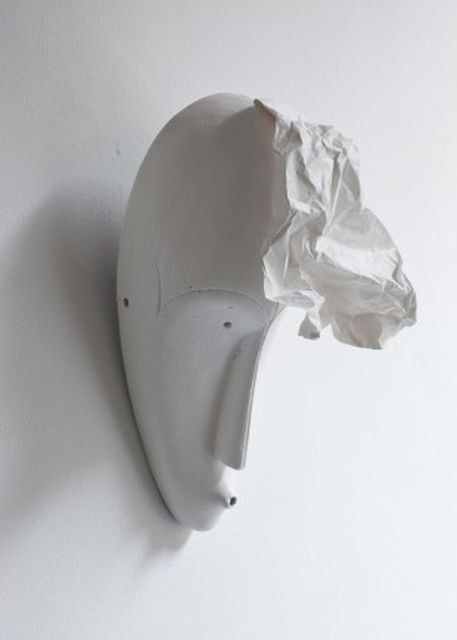
Jimmy Robert works with photography, performances, films and installations, in which he observes the instability of the image, raises questions about the relationship between object and representation and aims to make the spectator aware of his framework in which he views the world.
Robert’s photographs and collages are often sliced or folded into three-dimensional shapes and sometimes covered with masking tape. The original seems to be masked and charged with its own frame of interpretation. Instead of representing one single meaning, the object seems to reveal multiple meanings, thereby challenging the cultural codes within language, taste and aesthetic judgment.
Greatly inspired by the writings of Marguerite Duras and her use of descriptive passages in which her characters reveal themselves through what they say, or even more, through what they do not say, Robert also tries to make the unsayable perceptible. His films are often composed of images of unremarkable movements. The movements have been isolated and repeated until they reveal a density of meaning: mother’s hands stroking the head of her son; an arm running along the surface of a fence; fingers rubbing printed text.“It is not through painting that photography touches art but through theatre” (Jimmy Robert quoting Roland Barthes), it felt necessary to underline what is seen and how. For me it was therefore important to dramatize or sometimes even flatten out the performance into a two dimensional image by using plain light. Or to just remove the light totally, and so highlighting the fact that there is a directorial intent on what you see as a spectator and how.’
The title of the show is a short sentence appearing in Ingrid Caven, a book by Jean-Jacques Schuhl, which amongst other things gives an overview of the period when the actress had an affair with Fassbinder, and this remark is particularly directed against him.
For this exhibition, the expression will encompass a whole range of reflections, actual or more conceptual, various mirrorings of the idea of masculinity, and how perhaps men are an image hovering between two female gazes.
At once a total construct, a decorum, as well as a masquerade the notion of masculinity will be tentatively articulated within an installation of images, which will frame a performance. The performance will occur along an antique Japanese screen, which alludes to the artificiality of theatre as in a degenerate Noh where the essence is made clear not so much through the perfection of the form but rather the authenticity of the expression, where elements from Dan Graham and Yvonne Rainer are both a supporting structure and a frame. The screen will operate as a division of the space as well as a mode of display and concealment, it will support on its back the word, Indifferent, written very meticulously in various styles.
The images surrounding ‘the stage’ of the performance will become to a certain extent a makeshift audience, which in turn seems consumed by itself, by its own materiality.
Collected images, found or more known material, along with the mask titled ‘relaxed’ will be the witness of a dance/monologue addressing issues around the subject, movement and the gaze.
The question will not be so much who is on display as much as what? for which occasion? Perhaps very much a carnival as in an Ensor painting we are playing the roles we are expected to, hoping the various masks won’t fall off and reveal our inability to define ourselves truly independently.
Und das nennt sich mann… is about the lure, the conditioning of culture in the midst of a desire to participate, have a voice nevertheless. Paradoxically here I recall Frantz Fanon quoting Jean Veneuse, the French carribean poet: “Quand on aime il ne faut rien dire, il vaut bien mieux s’en cacher même”. Which would translate as: “If in love one should remain silent, one should even go as far as hiding it”.